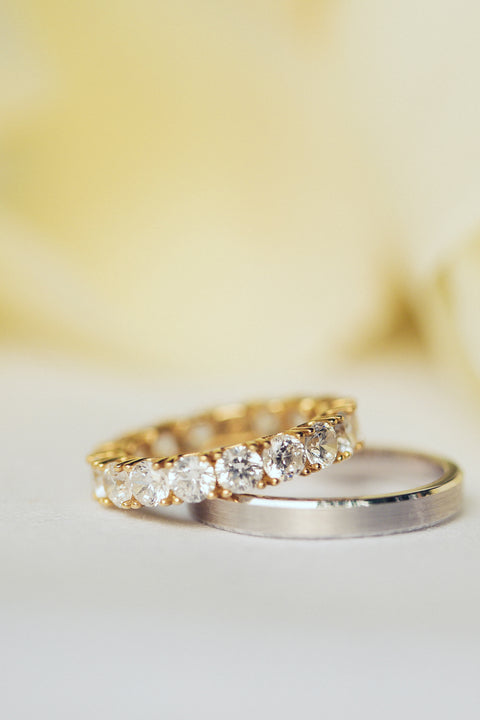Diamond shapes
About diamond shapes, and the cuts that are made
This is one of the parts of what are recognised as the 4Cs. These are used by the GIA to assess the quality of any individual diamond. The other Cs: diamond colour, carat weight and finally clarity. To discover more about each area, click on the word of your choice above. You can also click to appreciate the importance GIA Certification. You’ll discover when you examine your choices with our Kush Diamonds team that we always select stones of a Triple Excellent Cut (those delivering an excellent cut, polish, and symmetry).
Appreciating why the cut and shape of diamonds are crucial
One of the key reasons to handcraft a diamond engagement ring is for the final impression it then offers. This can also reflect the personality and style of the person lucky enough to wear it on their engagement finger. One of the ways this impression is made is by the cut of the diamond; one which allows its face-up appearance to flash, sparkle and dazzle with stunning radiance, when making any public appearance.
How a diamond cut reacts to light
When worn, a diamond ring will be subject to different types of light performance conditions. Its highly reflective surface will be affected in different ways. Where the light is spotted using LED sources, and this is also much the same as with direct sunlight, the diamond is likely to take on a more fiery hue than in those locations where the lighting is more diffused. Here, the visible diamond pattern of lights and darks is called scintillation. Where both of these types of light are present, your choice of diamond will often be able to show both these features.
Understand the key aspects of a superbly cut diamond.
A diamond’s cut is utterly critical and has been described as the key to unleashing its light and sparkle. The cut allows any diamond to be seen at its very best, in terms of how its facets interact with the light. It takes all the expertise and experience of our Kush Diamonds team to deliver the precise and handcrafted results our customers love. The results of their efforts and artistry are stones fashioned with the proportion, symmetry and polish needed to provide the magnificent return of light that our unmatched diamond engagement rings always deliver.
To understand how this is achieved, let’s consider the seven components used by the GIA in its Diamond Cut Grading System. Diamond Shapes are very complex and must to know. We’ve started with that vital brightness: being the internal and external white light that is reflected from any diamond. Next, fire: how the white light disperses and scatters across the colours of the rainbow; Then there’s scintillation: the various and changing sparkling patterns of light and darkness caused by a diamond’s internal reflections.
There are four more components, and each of these relate to a diamond’s design and the craftsmanship displayed in the cut, for example by our highly experienced and talented team here at Kush Diamonds. These are the weight ratio of the stone, its durability and polish, and the final one refers to its symmetry.
How the cut of a diamond is measured.
The GIA system carefully assesses each of the seven components, and how each relates to the overall quality of the cut diamond. The scale reaches from excellent to poor and refers to a range of both proportion sets and face-up appearances. Just as there are many different ways in which your face can appear appealing when the different elements work well together, so too are many different sets which do produce truly attractive diamonds. As with human attractiveness, it’s the desires and preferences of the individual who wears it that act as the final arbiter.
At Kush Diamonds, we only select and stock high quality stones, known as being of Triple Excellent Cut (excellent in their cut, polish and symmetry). We always choose only those with this excellent cut grading. As it’s very rare to find such high quality cut stones of varying specifications, this is one more way in which we deliver engagement rings which are as unique as they are stunning.
Understand the difference between diamond shapes and cuts.
The definition of either cuts and shapes can often appear to be interchangeable. However, the cut is the skilled arrangement of the facets (usually 57 or 58 in a brilliant cut diamond) which create the attractive face-up appearance; one of the true skills of our handcrafting team here at Kush Diamonds.
Round diamonds are by far the most popular choice and form the base shape for most diamond jewellery designs. For engagement rings,many alternative shapes and designs are available for you to consider
The following are frequently purchased shapes from our Melbourne CBD premises: Round Brilliant Cut, Princess Cut, Cushion Cut, Emerald Cut, Oval Cut, Pear Cut, Marquise Cut, Asscher Cut, Radiant Cut and Heart cut. Each of these is described in detail by clicking on your choice from this list.
How to consider the cut or shape of your diamond
With such a wide choice of shapes and cuts, and also different light and other considerations when choosing both your diamond and its setting, we’re sure there is more you would like to ask. Our Kush Diamonds experts are happy to offer their unmatched expertise in providing the information you need, and assisting in the choice you would wish to make. Simply call us now on 03 9602 3337.








